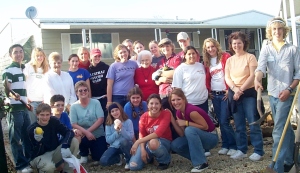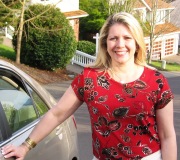
Blue Star Mother’s Flag
It is with a heavy heart that I write this blog post. This blog is actually a project highlighting my professional work for the conclusion of my Master’s Degree Program at the University of Nevada, Reno. Maybe this will be my last post, maybe I will continue to blog. But, I cannot potentially end my blogging about volunteerism without mention the ultimate volunteers…the servicemen and women who wear the uniform of the United States military.
My brother and his wife will leave shortly for the war zone in the Middle East. This is my brother’s third tour, the first two he served in Tikrit and Baghdad, Iraq at 19 and 24 years old. Sure, he is paid by the government, but he has volunteered to put his life on the line to promote freedom and liberty abroad.
The sacrifices are many. He leaves behind his 10 year old stepson, who will go a school year without his parents. My aging parents, who live across the country from where my brother is stationed, have anxiety and concern when my brother is abroad. He is afforded the opportunity to return home on occasion, but with the responsibilities for his own family that has proven difficult.
Where he is headed is extremely dangerous. Although his first trip to Iraq, he was stationed in the home town of Sadaam Hussein when the dictator was executed and put to rest there. This tour, his safety is much more at risk. I am unable to mention his duties due to his security clearance and for his safety, but we are all very concerned for him much more this time around.
However, he is not concerned. He is eager to return to that part of the world and promote freedom for people who have lived without it. He anticipates joining his fellow soldiers and supporting them in their duties while he counts on them. With his sacrifice of his family at home, he is comforted by the family included in an entire division of soldiers.
My brother is a volunteer. He is a veteran following the footsteps of my father and grandfather who served in the Vietnam conflict and World War II. We do not live in a country that conscripts young people into service. Our military is supported by the brave youth who take a stand and raise their hand to volunteer. For whatever their reasons are, they still do it.
When my brother returned from Iraq the first time, my sister and I flew to Hawaii, where he was stationed. We met many of his friends who he served with. I was amazed at how many of these young soldiers were of little financial means and many times familial support. My brother had the opportunity to attend college and choose another path, but he chose the Army. For many of his cohorts, the military is the best opportunity for them. It provides structure and a means to survive. I think of these young soldiers and the sacrifices they make while people like me and my sisters sit at home in California and enjoy our carefree lives.
If you know a soldier who is deployed, write a note, send an email, and let them know you are thinking of them. My mom emails soldiers who serve with my brother who do not have ANY family support AT ALL. Volunteer for the Wounded Warrior Project and affiliated events in your area. Volunteer for an organization that supports the families that are left behind. Thank a veteran for their service. Pray to God that they all come home safely.
Please share a story about your favorite soldier or veteran. Make YOUR difference in the world…Volunteer!

 One of the sweetest people I have ever met is Mary Stansell. Mary was a coworker who worked in a
One of the sweetest people I have ever met is Mary Stansell. Mary was a coworker who worked in a 




 There is an abundance of good work that takes place in our communities, and it might not be obvious or well-known. It is the work of volunteers through faith-based organizations of every denomination. The religious purpose of volunteering adheres to a higher purpose, and many in the faith-based community aspire to this principle. Faith-based organizations, such as the
There is an abundance of good work that takes place in our communities, and it might not be obvious or well-known. It is the work of volunteers through faith-based organizations of every denomination. The religious purpose of volunteering adheres to a higher purpose, and many in the faith-based community aspire to this principle. Faith-based organizations, such as the 

 Being grateful for a kind word, an act of kindness, or a recipient of service is one thing. Expressing gratitude to the messenger, Samaritan, or volunteer is certainly another. While volunteers make a difference in the lives of others, recipients can make a difference in the lives of the volunteer simply by saying “Thank You.” I have learned to never underestimate the power of gratitude.
Being grateful for a kind word, an act of kindness, or a recipient of service is one thing. Expressing gratitude to the messenger, Samaritan, or volunteer is certainly another. While volunteers make a difference in the lives of others, recipients can make a difference in the lives of the volunteer simply by saying “Thank You.” I have learned to never underestimate the power of gratitude.